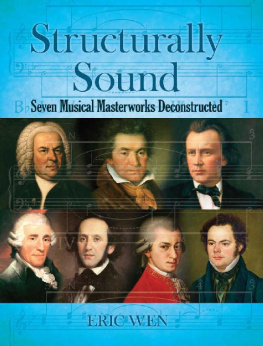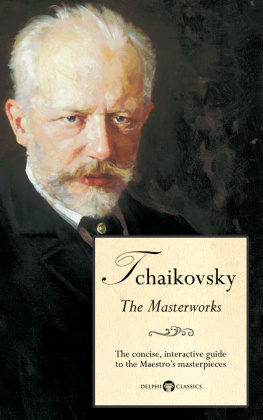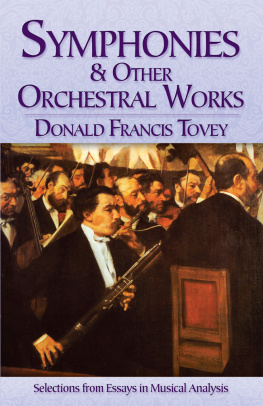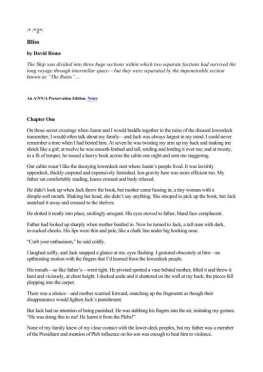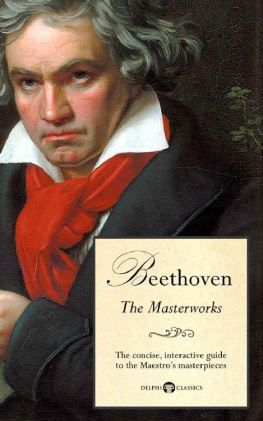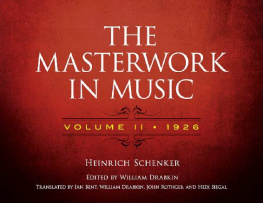Structurally Sound
Seven Musical Masterworks Deconstructed
Structurally Sound
Seven Musical Masterworks Deconstructed
Eric Wen
DOVER PUBLICATIONS, INC.
Mineola, New York
Copyright
Copyright 2017 by Dover Publications, Inc.
All rights reserved.
Bibliographical Note
Structurally Sound: Seven Musical Masterworks Deconstructed is a new work, first published by Dover Publications, Inc., in 2017.
International Standard Book Number:
ISBN-13: 978-0-486-80677-8
ISBN-10: 0-486-80677-4
Manufactured in the United States by LSC Communications
80677401 2017
www.doverpublications.com
To Florence, Lily, Rachel, and Tovi
CONTENTS
BACH Air
from Orchestral Suite No. 3 in D, BWV 1068 |
MENDELSSOHN Andante con moto tranquillo
from Piano Trio No. 1 in D minor, op. 49 |
HAYDN Adagio Vivace assai
from Symphony No. 94 in G, Hob. 1:94 |
MOZART Molto Allegro
from Symphony No. 40 in G minor, K. 550 |
BEETHOVEN Marda funebre: Adagio assai
from Symphony No. 3 in E-flat, op. 55 |
BRAHMS Un poco presto e con sentiment
from Violin Sonata No. 3 in D minor, op. 108 |
ACKNOWLEDGMENTS
The work of Donald Francis Tovey was my first introduction to music analysis. Ever since encountering his multi-volume Essays in Musical Analysis as a teenager, I have relished his analyses of my favorite pieces. His many astute observations on individual worksas well as his many other general essaysstill stand up as models of cogent music writing. Although he wears his scholarship lightly, Toveys penetrating insights, coupled with his inimitable wit, have set a gold standard for thinking and writing about music.
Heinrich Schenker was an exact contemporary of Tovey, but in many ways represents his polar opposite. His desire to uncover the essence of musics structure is far from the empiricist approach of his English counterpart. Schenkers prose is often difficult to negotiate, even for those fluent in his native German tongue. His dense writing style, rich in poetic imagery and philosophical allusions, has a tendency sometimes to obscure his ideas. Moreover, his occasional uncompromising and contemptuous attitude is not endearing. Yet despite this hurdle, Schenkers contribution to the field of music theory is unparalleled. More than any other writer on music, he devised a way of revealing as never before the concept of organic coherence in tonal music. In fact, two of the works included in this collectionthe Mozart and Beethoven symphony movementshave been subjected to Schenkers rigorous scrutiny. Although my interpretations are very different from his, I have learned enormously from and am deeply indebted to his perceptive readings.
My third and most direct influence is Carl Schachter. As a first-year college undergraduate I took a course in species counterpoint using the textbook Counterpoint in Composition, co-authored by Felix Salzer and Carl Schachter. Having gone through the writing of strict counterpoint, I was dismayed to discover that the course ended after the first five chapterswhy didnt we cover the remaining chapters with their discussion of the relationship between counterpoint and actual works of music? As a brazen teenager, I looked up Felix Salzers phone number in the telephone directory (this was long before the Internet), and, after explaining the reason for my call, asked if I could study the remainder of the book with him. Perhaps daunted by my youthful insistence, he kindly invited me to meet him at his apartment (the only time I was ever in contact with him personally). After asking why I wanted to study analysis, he then explained briefly who Schenker was, and went to the piano to demonstrate a few analytical points. Afterwards, Dr. Salzer told me that he no longer gave private lessons, but that he would contact his co-author Carl Schachter to see if it might be possible for me to study with him. I subsequently arranged to meet with Carl at his home, where he asked about my (very limited) musical background and the reasons for my wanting to study theory privately. After asking me to explain a short passage of music (the beginning of the slow movement of Beethovens Piano Sonata in A, op. 2, no. 2) and some aural tests, he said: I dont have any time to take on any private students, and had made up a list of several people in mind for you to work with, depending on your musical level. However, Im going to make an exception, and take you on.
I worked for three and a half years with Carl on a weekly basis as a private student. Our work together consisted primarily of writing counterpoint (including fugue), harmonizing chorales, and pastiche composition. We didnt undertake any analysis for three years; only in the last six months of our working together did we venture into looking at actual pieces. Looking back, the intensive training in musical techniques I received on a weekly basis was the best preparation I could have ever had for doing analysis. One of the last pieces we worked on together was the wonderful Schubert song Nacht und Trume included here. To this day, I recall the moment of revelation when I realized how all our work in harmony and counterpoint could be applied to a deep understanding of a piece of music. I remember that Carl seemed pleased with the analysis I had done, and felt that our work together prepared me sufficiently to start graduate school later in the fall. Although my reading is different in several details from Carls own published analysis, the spirit of the interpretation is the same, and I have chosen to include it here as an homage in recognition of a debt I can never repay.
Among others who have influenced me in various ways are my professional colleagues Kevin Korsyn, Wayne Petty, and William Rothstein, all of whom are exceptional musicians whose work has often stimulated me. Although not in academia, Mark Holland, Larry Laskowski, and Channan Willner are three other outstanding musicians who know more about the spirit of Schenker than most professional music theorists, and have given me support in numerous ways. I also owe thanks to two of the most outstanding pianists of our age: Murray Perahia and Andrs Schiff. Sharing a deep interest in the inner workings of music, it is a great honor to count them among my friends. Finally, I would like to express my gratitude to all the staff at Dover Publications, especially Rochelle Kronzek for commissioning this book, and my editor Gregory Koutrouby and designer Jennifer Becker, who jointly undertook the painstaking step-by-step process of overseeing the projectcomplete with more than 1,000 separate musical examplesthrough to its final realization in print. Given the budget constraints and commercialism so prevalent in publishing today, Dovers commitment to disseminating serious music books including reprints of seminal works by Tovey and Schenkerrepresents a rare commitment to scholarship.
Most of all, I must thank my family, who have endured my constant, obsessive passion for music. I am deeply grateful for the patience and understanding shown to me throughout the writing of this book. Their loving support gave me the energy to persevere and complete Structurally Sound.
The main lesson of the analysis of great music is a lesson of organic unity.
Donald Francis Tovey
PREFACE
Music is perhaps the most enigmatic of all the arts. How is it that a sequence of sounds, formulated as distinct pitches and organized in different units of time, can communicate the most intense and complex emotions? In literature, words have distinct meanings, and a writer uses them to communicate a wide variety of ideas and depict real or imagined situations. In the visual arts, a painter or sculptor uses colors and shapes to portray events and people with striking realism or to convey an abstract impression.

